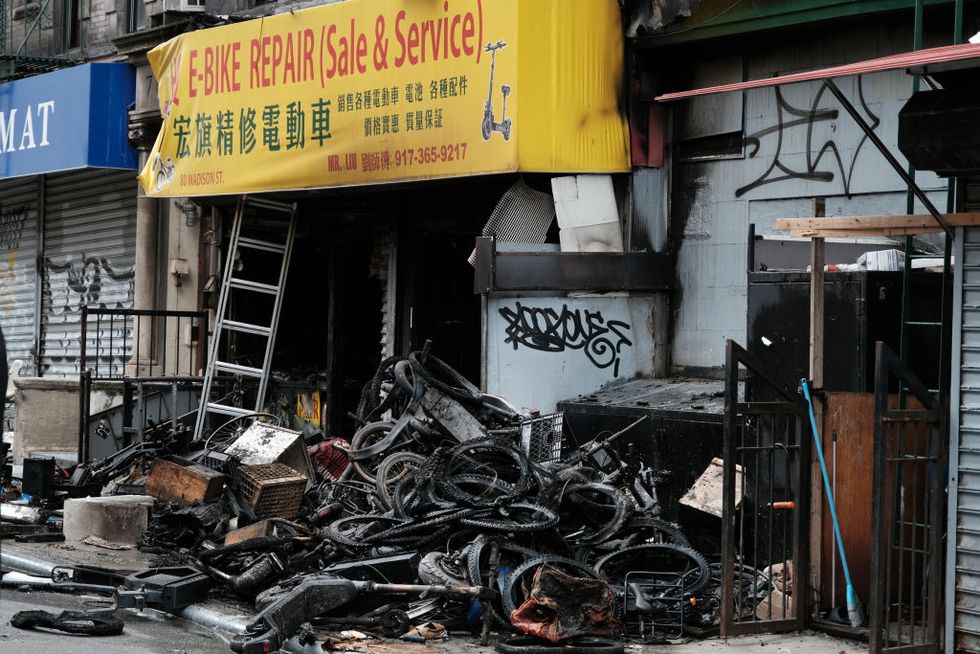- The Fremantle Highway cargo ship caught fire earlier this summer, blamed on an EV or EVs among the 3784 Mercedes-Benz and BMW models on board, of which 498 were battery-electric.
- The data suggest ICE vehicles catch fire at a higher rate than EVs, says Guidehouse senior analyst Mike Austin.
- Emerging lithium-iron phosphate batteries contain no flammable liquid electrolytes. Leave out the nickel cadmium chemistry that makes up lithium-ion batteries, and you give up the source of fire-fanning oxygen.
In the early days of the automobile, attached garages were considered a bad idea. Why park a car with a filled gas tank in a building attached to the rooms where we eat and sleep?
Now it’s the electric vehicle’s turn to fight that misperception. It doesn’t help that e-bikes and e-scooters using the same sort of nickel-cadmium-based lithium-ion batteries have been catching fire while charging inside New York apartments.
Then there’s the US Department of Transportation’s late-2016 ban of Samsung Galaxy Note 7 phones from airplanes, and General Motors more recently advising, twice, that Chevrolet Bolt owners park their cars after a few high-profile fires.
On August 18 Nikola recalled all 209 battery-powered electric semi-trucks and suspended sales after an investigation found a leak inside the battery case as responsible for causing a “minor thermal incident” on an engineering validation truck, according to Reuters (the recall does not affect its hydrogen fuel-cell-powered trucks).
No less notorious is the Fremantle Highway cargo ship fire earlier this summer, blamed on an EV or EVs among the 3784 Mercedes-Benz and BMW models on board, of which 498 were battery-electric, according to Automotive News Europe.
“‘If it bleeds it leads,’ is how reporting on EVs works,” says Sam Fiorani, vice president of Global Vehicle Forecasting for AutoForecast Solutions.
“It doesn’t matter if ICE vehicles catch fire more often, or even as often as EVs. The pictures are more spectacular, and it plays on the public’s fear of the unknown. Showcasing another ICE vehicle fire does nothing for ratings or readership, but place one photo or video of a Tesla burning up and watch the clicks roll in.”
The data suggest ICE vehicles catch fire at a higher rate than EVs, agrees Mike Austin, senior research analyst on electric vehicles for Guidehouse, and a former editor for Car and Driver. But EV fires just happen to be, er, more explosive.
“Nickel-based chemistries create their own oxygen during a thermal event, which means they burn fast and are hard to extinguish,” Austin says. “In the case of cargo ships, EVs present a problem because even if they aren’t the cause of the fire, if a fire is large and hot enough to ignite the battery pack you have a big problem.”
Regarding the Chevy Bolts, GM recommended owners park the car outside and limit the maximum charge to 90%, which plays a factor if there is a fault in the battery, he says. “Moreover, nickel-based chemistries seem to last longer when regularly charged to 80% or 90%.”
Bigger Fire Threat with Bikes and Scooters
What about e-bike fires? According to The New York Times, lithium battery fires from e-bikes and e-scooters have killed 14 people and injured 93 others, with 154 fires reported in New York City as of August 14.
Local Law 39, which takes effect September 16, will “prohibit the sale, lease or rental of e-bikes and e-scooters—along with their batteries—that fail to meet recognized industry safety standards,” the Times reports.
Austin says the simple explanation for why a battery might catch fire is due to a fault in the system that causes thermal runaway, and the new law targeting failure to meet safety standards backs that up.
These include “things like manufacturing defects, physical damage, a fault in the battery management that results in over-charging, or some combination of those conditions,” he says.
“When you look at e-bike and e-scooter fires, the likelihood of those problems is a lot higher—or at least it’s easier to call the componentry into question. For automakers, they spend a lot of effort to eliminate those faults and make sure the battery is still safe when there is a fault. Over-engineering is a lot cheaper than replacing tens of thousands of battery packs in a recall.”
Lithium-ion batteries rule in everything from smartphones to battery-electric semi-trucks, but emerging technologies such as lithium-iron phosphate (LFP) and solid-state batteries—which contain no flammable liquid electrolytes—virtually eliminate the problem, Austin notes.
And LFP batteries are less likely to have a “thermal event” (i.e. a fire) in the first place, says Mujeeb Ijaz. As chief executive officer and founder of One Next Energy (ONE), Ijaz has good reason to tout the advantages of the battery technology his company develops. He also has science on his side.
“In particular, nickel-cadmium (NCM, in li-ion batteries) contains reactive metal-oxygen bonds,” Ijaz says. “During an abuse event, the oxygen in NCM oxidizes the electrolyte, generating the heat that drives the thermal runaway process.”
In other words, leave out the nickel cadmium chemistry that makes up lithium-ion batteries, and you give up the source of fire-fanning oxygen.
Is the perceived threat of a car fire preventing you from buying a battery-electric vehicle? Please comment below.
Contributing Editor
As a kid growing up in Metro Milwaukee, Todd Lassa impressed childhood friends with his ability to identify cars on the street by year, make, and model. But when American automakers put an end to yearly sheetmetal changes, Lassa turned his attention toward underpowered British sports cars with built-in oil leaks. After a varied early journalism career, he joined Autoweek, then worked in Motor Trend’s and Automobile’s Detroit bureaus, before escaping for Mountain Maryland with his wife, three dogs, three sports cars (only one of them British), and three bicycles. Lassa is founding editor of thehustings.news, which has nothing to do with cars.
Read the full article here



